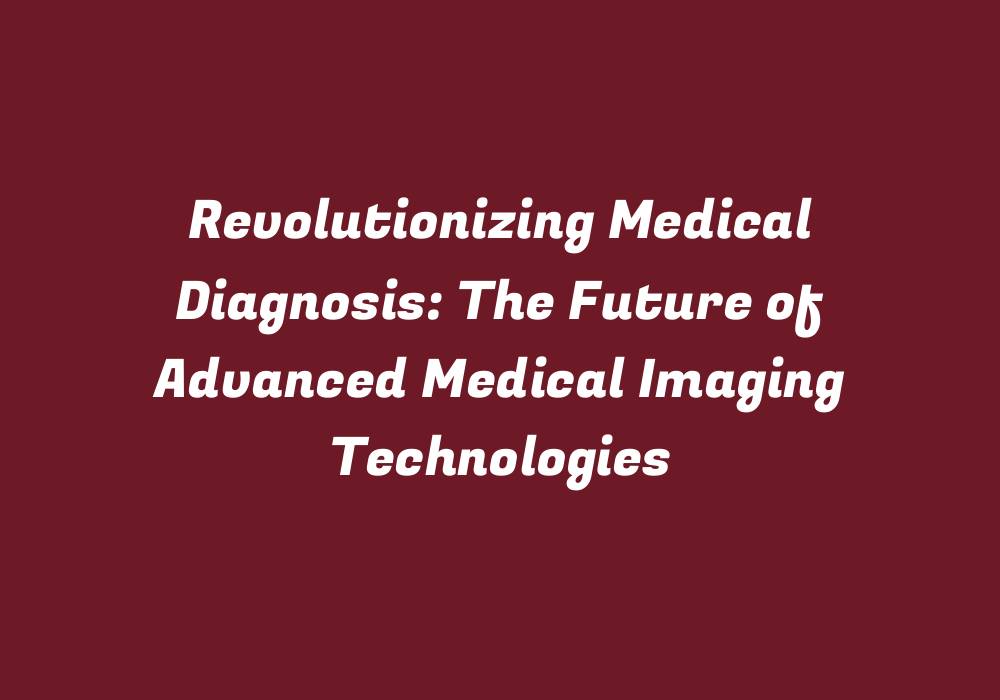Introduction
In recent times, the healthcare industry has witnessed a significant transformation with the introduction of advanced medical imaging technologies. These innovative tools have revolutionized the way physicians diagnose diseases and monitor health conditions, resulting in more precise treatment plans and improved patient outcomes. In this article, we delve into the future of advanced medical imaging technologies and their impact on medical diagnosis.
H2: The Evolution of Imaging Technologies
The history of medical imaging spans decades, starting with simple X-rays in the early 1900s. Since then, various technological advancements have led to a diverse range of modalities, each offering its own unique set of advantages and limitations. Some noteworthy innovations include:
1. Computed Tomography (CT) – Introduced in the 1970s, CT scans provide detailed cross-sectional images of various organs and tissues by using X-rays to capture multiple views from different angles.
2. Magnetic Resonance Imaging (MRI) – Developed in the 1980s, MRI utilizes powerful magnetic fields and radio waves to create detailed three-dimensional pictures of internal body structures without exposing patients to ionizing radiation.
3. Positron Emission Tomography (PET) – Invented in the 1970s, PET scans use a radioactive tracer that emits positrons after being administered intravenously or ingested orally. These positrons interact with surrounding tissue, allowing for detailed images of metabolic processes and chemical reactions occurring within cells.
4. Ultrasound – Initially introduced in the 1950s, ultrasonography uses high-frequency sound waves to create images of internal organs, tissues, and blood flow. This modality is commonly used during pregnancy and for evaluating soft tissue structures.
H2: Advanced Medical Imaging Technologies: The Future of Diagnostics
In recent years, medical imaging has taken a giant leap forward with the development of novel technologies that promise to revolutionize disease diagnosis and management. Some emerging advanced medical imaging systems include:
1. Quantum Dot Imaging (QDI) – This technique utilizes tiny particles called quantum dots, which emit light when excited by laser or other light sources. When administered to the body, these nanoparticles can help diagnose various diseases more accurately due to their superior sensitivity and versatility in imaging techniques.
2. Photoacoustic Tomography (PAT) – A combination of ultrasound and optical imaging, PAT utilizes laser-induced acoustic waves to create 3D images at a high resolution. This innovative technology has shown promise in detecting breast cancer and monitoring tissue oxygenation levels.
3. Elastic Scattering Tomography (EST) – EST is an emerging technique that uses elastically scattered X-rays to generate detailed, three-dimensional images of the body’s tissues. The method offers better contrast than conventional CT scans, allowing for more accurate diagnosis and treatment planning in various clinical situations.
4. Molecular Imaging (MI) – By utilizing specific imaging probes that interact with molecular targets within cells or tissues, MI can offer unprecedented insight into the biological processes underlying disease mechanisms. This technique holds great potential for early detection of cancer and other complex conditions.
5. Intravascular Ultrasound (IVUS) – IVUS is a combination of conventional ultrasound technology with catheters inserted into blood vessels to provide high-resolution images of the vessel walls. This method assists in diagnosing and treating various cardiovascular diseases, particularly those involving blockages or abnormal growths within the vasculature.
H2: Enhanced Patient Outcomes and Precision Medicine
As advanced medical imaging technologies continue to evolve, they are expected to play a pivotal role in driving the shift toward precision medicine. This approach takes into account individual variability in genetics, environment, lifestyle, and other factors when designing tailored treatment strategies that maximize effectiveness and minimize side effects for each patient.
Advanced imaging technologies enable clinicians to capture detailed information on anatomical structures and physiological processes, which can then be analyzed to develop targeted therapies based on the unique characteristics of each patient’s disease. For example, molecular imaging can guide personalized immunotherapy approaches in cancer patients by identifying specific biomarkers that predict their response to particular treatments.
H2: Challenges and Limitations in Adoption
Despite the promising potential of advanced medical imaging technologies, there are several challenges and limitations that need to be addressed for widespread adoption across healthcare systems. Some key factors include:
1. Cost and accessibility – Developing and implementing innovative imaging techniques is often accompanied by substantial financial investment, which can be a barrier for many healthcare providers, particularly those in resource-limited settings.
2. Technological standardization – Due to the rapidly evolving nature of advanced medical imaging technologies, it is crucial to establish uniform standards for data acquisition, analysis, and interpretation to ensure accurate comparisons across different modalities and patient populations.
3. Privacy and data security concerns – As these novel techniques collect vast amounts of sensitive patient data, it is essential to maintain strict protocols regarding privacy and data security to protect patients’ rights and prevent misuse of their information.
4. Clinician training and acceptance – For advanced imaging technologies to be fully adopted, healthcare professionals must receive proper education and training on new methodologies to ensure they are comfortable using them in a clinical setting. In some cases, this may also require shifting mindsets away from established diagnostic paradigms.
Conclusion
Advanced medical imaging technologies represent an exciting frontier of innovation that promises to revolutionize disease diagnosis and management across various healthcare specialties. As these novel systems continue to develop and mature, their impact on patient outcomes can only be expected to grow in significance. By addressing the challenges inherent to this rapidly evolving field, clinicians can harness the power of advanced medical imaging technologies to deliver more effective, personalized care for patients around the world.
